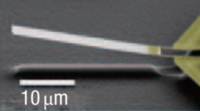US scientists have built a device capable of detecting masses as small as 1 attogram (1 x 10-18 g) at ambient temperature and pressure. This sets a new record for detection under these conditions, they claim. Previous devices have required high vacuum and low temperature in order to achieve comparable sensitivity.
Michael Roukes, of California Institute of Technology, Pasadena, US designed the sensors around a tiny cantilever a few hundred nanometres across that vibrates like a diving board. When an object rests on the 'diving board' the frequency at which it vibrates changes in proportion to the mass of the object.
A thin layer of gold deposited on the silicon carbide cantilever is the key to the device's performance. Gold is piezoresistive, meaning its resistance to electrical current changes when it is stretched or compressed. Changes in the vibration frequency of the cantilever can therefore be detected by changes in the current passing through it, without the need for a comparatively large external detector.

Weighing in on the nanocantilever diving board
© Nature
|
David Carey, a nanotechnologist at the University of Surrey, UK, described the study as 'an excellent piece of work.' Previous devices have been made from semiconducting materials but moving to metals 'opens up a whole series of properties' that make this technology so promising, Carey told
Chemistry World. Metals have more charge carriers than semiconductors, which results in better temperature stability, less noise and ultimately greater sensitivity of measurement. Carey was also impressed that the cantilevers lose very little vibrational energy to the air even at ambient pressure.
The icing on the cake is a very thin film of poly(methyl methacrylate) (PMMA), which allows selective and reversible chemisorption of analyte molecules to the tiny cantilever's surface. Roukes' team observed a real-time response to pulses of 1,1-difluoroethane gas in air at room temperature and pressure. Mass peaks as small as 1 attogram could be resolved.
The results will lead to 'renewed impetus into mass detection under realistic conditions' using this type of device, concluded Carey.




